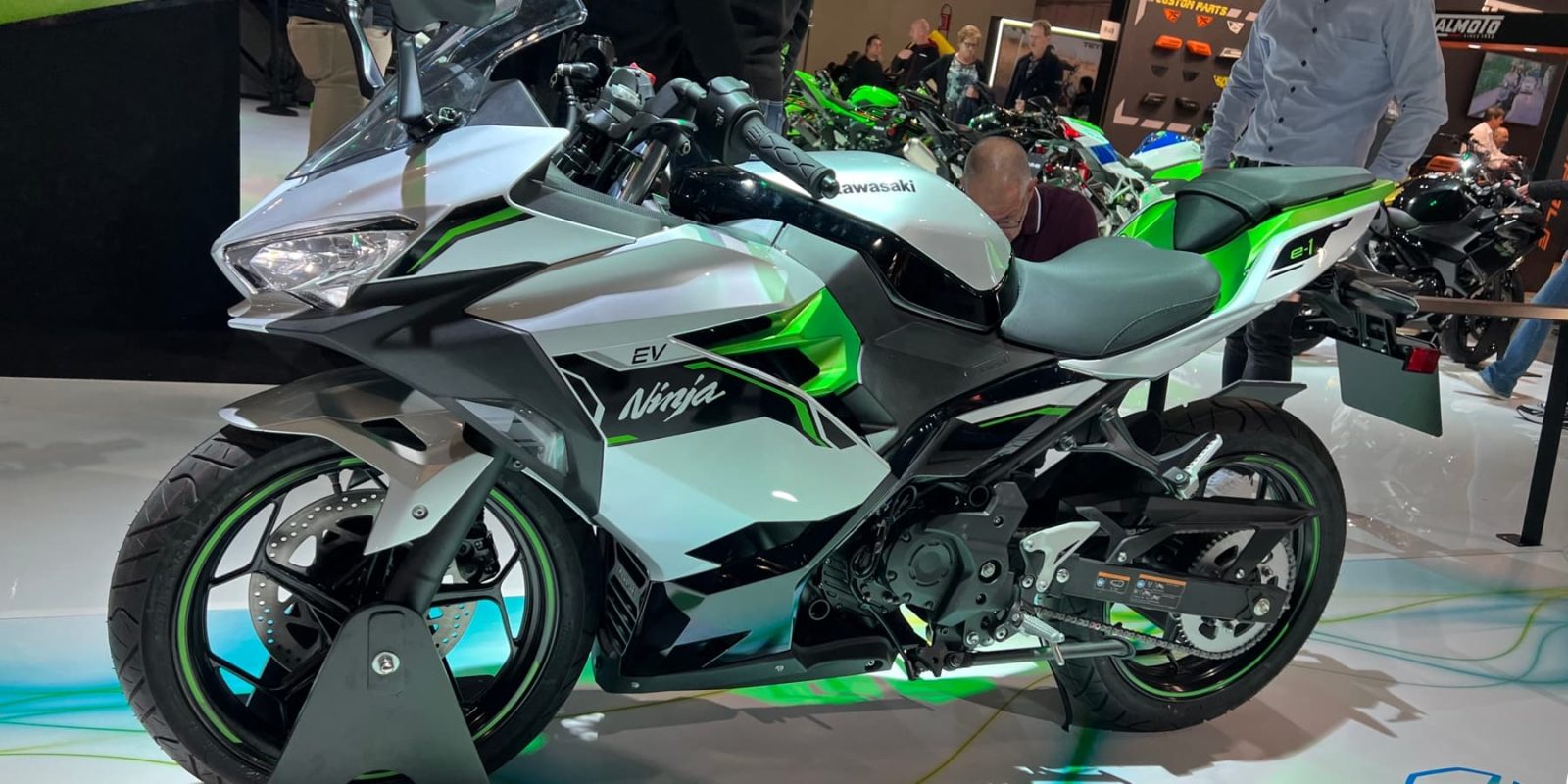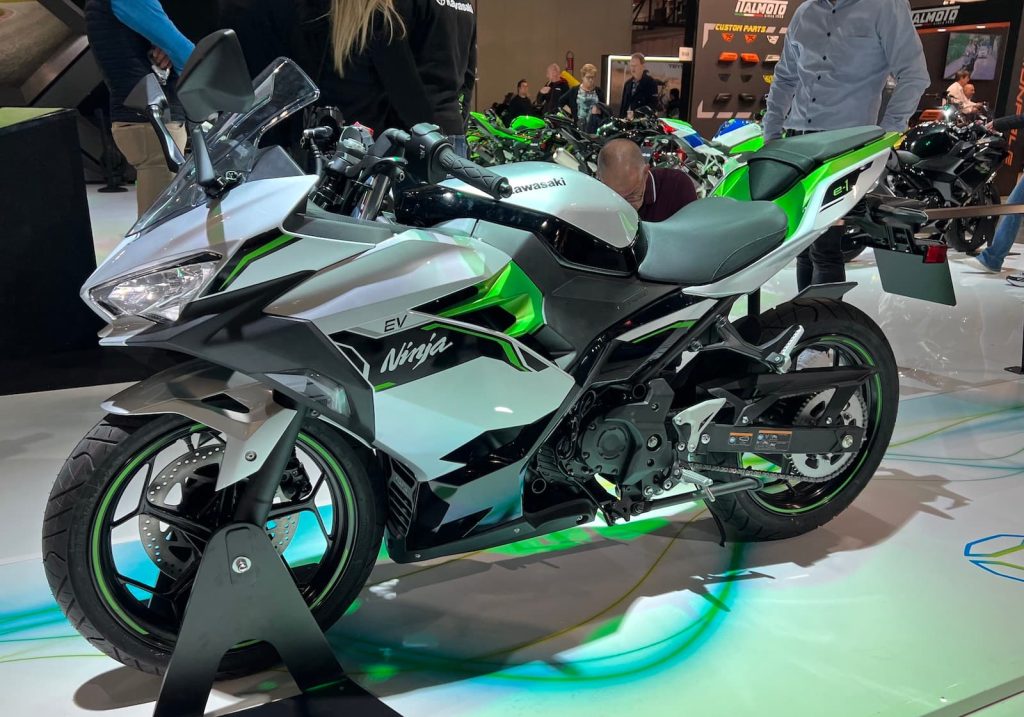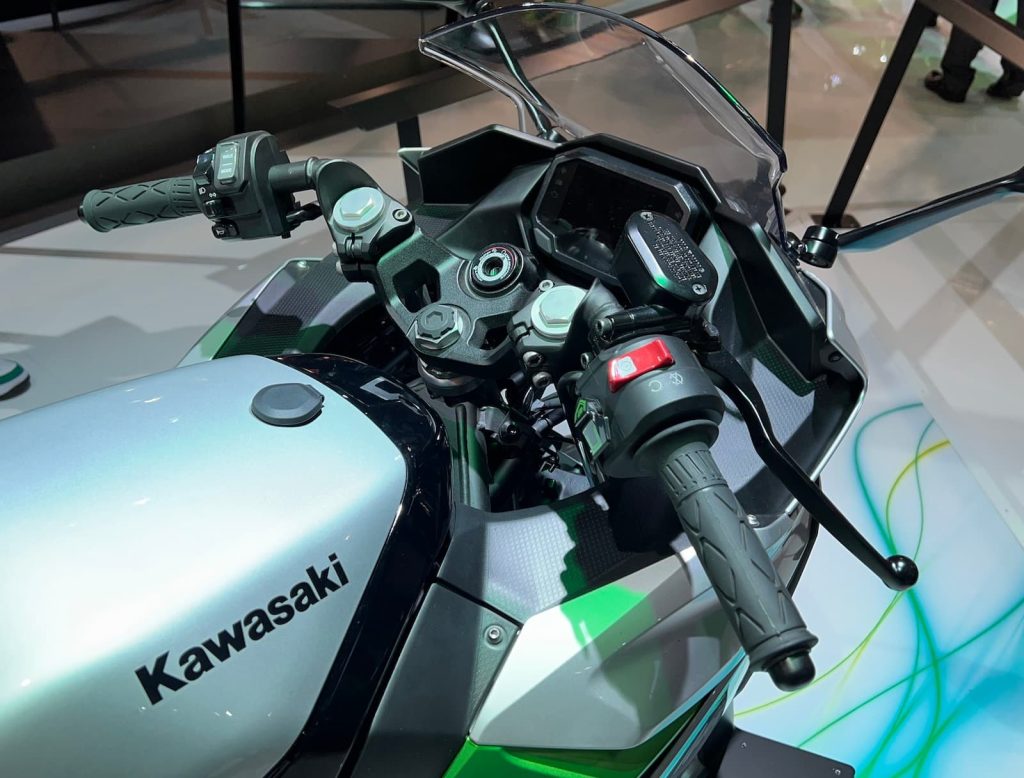
Kawasaki’s upcoming new electric motorcycles are set to help the brand usher in the future of motorcycling. This month, we got the chance to check them out in person and take a closer look at the Kawasaki Ninja e-1 and Z e-1 models.
Both models were on display at the 2023 EICMA Milan Motorcycle Show. No one can accuse Kawasaki of rushing too quickly toward electrification. The company dragged its feet compared to other major legacy motorcycle manufacturers such as Harley-Davidson and BMW.
But among the Japanese big four, Kawasaki has managed to beat out Honda, Yamaha, and Suzuki to become the first to bring a full-size electric motorcycle to market.
The Kawasaki Ninja e-1 (faired sportbike below) and Z e-1 (naked bike) are both set to begin sales soon in the US and European markets, where riders will be able to purchase them at existing Kawasaki dealers.
Last month, we finally received the long-awaited pricing details. In the US market, the Ninja e-1 will carry a US $7,599 price tag, while the 2024 Z e-1 starts at a slightly lower US $7,299.

I had the chance to hop on both bikes at the show, and veteran Kawasaki enthusiasts will likely be pleased to hear that despite the unfamiliar drivetrain, they largely look and feel much like the ICE-based models they are based upon. Or at least they do while sitting still.
Kawasaki hasn’t given out test rides yet so it’s hard to say how they handle. Still, they certainly don’t appear as foreign as several of the more futuristic-looking electric motorcycles hitting the market.
The downside is that while it may look like a traditional Ninja, the performance is certainly more muted. Electric motorcycles can lay down impressive power and track times, but several manufacturers have eschewed the larger electric motors and batteries required for that performance. Instead, smaller motors and batteries have worked their way onto bikes like the Kawasaki Ninja e-1 and Z-1. That’s resulted in closer to 125cc-equivalent commuter-level performance.
For example, the Kawasaki Ninja e-1 and the Z e-1 both share the same 5 kW electric motor rated for 9 kW of peak power in bursts. That’s around 12 horsepower at full tilt, meaning these bikes aren’t exactly going to stand on their tail very easily.
There are two riding modes, Eco and Road mode. The bikes have a boost button that increases the burst power and top speed temporarily. Eco mode will use lower power and is limited to 40 mph (64 km/h) but can hit 47 mph (76 km/h) in boost mode. Road mode offers a higher constant speed of 55 mph (88 km/h) but can be boosted up to 65 mph (105 km/h). The E-Boost feature will only last for 15 seconds, so riders would be advised to use it wisely in an overtaking situation.

Both models use a pair of removable 1.5 kWh battery packs, offering a combined 3 kWh of capacity. That’s even smaller than the troubled SONDORS Metacycle’s 4 kWh battery pack, which has led to criticisms of that bike’s low range.
With 3 kWh of battery capacity on board, Kawasaki says the two motorcycles can achieve 41 miles (66 km) of range in Road mode without using the electric boost feature. There’s no word from the manufacturer on what speed that range is measured at, but that figure works out to an efficiency of 73 Wh/mile and thus is likely around 35 mph (56 km/h) of average speed.
The batteries, which weigh 25 lb (11 kg), can each be recharged completely from a typical wall outlet in under four hours or from 20-80% in under two hours. Kawasaki was not demonstrating the removable batteries at the show.
The ease of recharge is designed to be convenient for any urban residents who cannot charge in a typical garage setting. Carrying the batteries up to an apartment would allow such city-dwellers to charge their batteries despite parking on the street.
Top comment by Ruaraidh
This is a dismal offering from Kawasaki: These are barely learner city bikes compared with what's out there right now. Japan's failure to electrify across the board continues.....
However, the limited range of the bikes will limit their use to largely urban and commuter use.

So while the motorcycles certainly look and feel the part, managing to distill Kawasaki’s DNA in the design, it’s hard to say if traditional fans of the brand will be won over by the limited performance.
However, with prices starting well under $8,000 and the promise of a large network of support and service behind it, Kawasaki may be able to snatch up more of the growing market comprised of new riders suddenly interested in the advantages and approachability of electric motorcycles.
What do you think? Could you see yourself on one of Kawasaki’s new electric motorcycles? Let’s hear your thoughts in the comment section below.

FTC: We use income earning auto affiliate links. More.



Comments